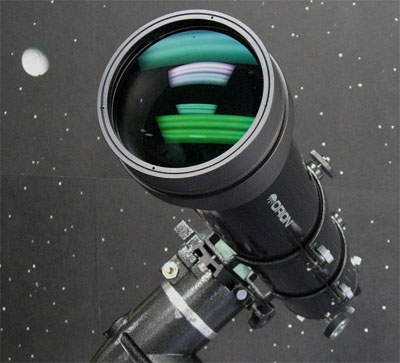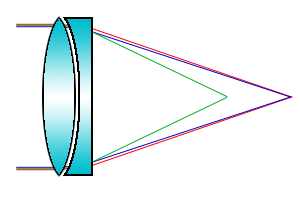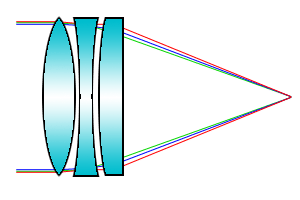Telescope Topics 3.
Refractors - getting close to optical perfection.
There must be something in this, otherwise why would so many amateur astronomers eulogise them and be willing to pay significant sums of money to acquire the very best? Well, there is something rather special about the image seen through a top flight refractor: the stars are pretty well point-like across a very wide field and (if there is no moon) stand out against a jet black sky. They can produce exquisite images of the planets and star clusters but, as their aperture is limited they are not really suitable for serious deep-sky observing.
Click on the Image to see a high resolution version

A 120 mm aperture refractor
There are some real reasons for this. The image quality is essentially limited by the laws of physics, as there is no "obstruction" in the centre of the light path due to the secondary mirror used in virtually all reflecting telescopes. This helps to give the "pin-point" images. The lenses absorb and scatter almost no light so virtually all the light entering the telescope reaches the eye whereas mirrors absorb and scatter some light so leading to slightly less bright images and, much more importantly, reduced contrast in the image. As the light beam narrows down the tube of a refractor to the focus, it can be well baffled to further reduce any scattered light and, as it the light beam only travels through the tube once, air current will have less effect that in Newtonians (two passes) and Schmidt-Cassegrains and Maksutovs (three passes). It also appears that lenses require very little time to come to thermal equilibrium so refractors are almost "pick up and go" scopes and have the further advantages of holding collimation and requiring little on no maintenance.
So why do we not all have one? Refractors become unwieldy beyond an aperture of ~ 6 inches so they do not make good deep-sky scopes (where aperture is important) except under very dark skies. But perhaps one reason is the fact that lenses inherently suffer from chromatic aberration (false colour) giving colour fringes around bright images such as the Moon and Venus. This can now be virtually fully corrected - but at a price.
The focal length of a simple bi-convex lens depends upon its refractive index, n. For crown glass in green light n is 1.517. BUT, the refractive index varies with colour and for blue light is 1.524 and red light 1.515. For a simple lens with a focal length in green light of 1000mm, the blue light will come to a focus at 986.6 mm and the red light at 1004 mm - a spread of 17.4 mm! If one focuses for the green light, the red and blue light will be well out of focus and cause a purple haze around the green image (red + blue = purple).

An achromatic doublet cannot bring all colours to the same focus
In 1729 Chester Moor Hall invented the achromatic doublet by combining a convex lens made of crown glass with a concave lens made of flint glass. In this case, the focal length depends on twice the refractive index of the crown glass minus that of the flint glass (2n1-n2). Amazingly, this is almost a constant: the values for blue, green and red light are 1.409, 1.407 and 1.408 respectively, giving focal lengths of 998.6 mm, 1000 mm and 999.3 mm. The spread is just 1.4mm - over 12 times better! There is still a little colour fringing but with focal ratios of f12 and apertures of say 3.5 inches the images were pretty good. So for much of the19th century most amateur telescopes were achromatic refractors. But then the deep-sky observing came into vogue and, with the rise of the Newtonian telescope, refractors became largely ignored.
I the 1970's, an amateur astronomer called Roland Christian discovered a cache of exotic glass in a NASA warehouse and realised that he could produce lenses with three elements (a triplet lens) that had essentially no chromatic aberration. These are called apochromats. Telescopes, now made by his company Astro-Physics are prized possessions and the waiting list for buying a new one stretches into years. In Japan, Takahashi used a lens made out of a crystal of fluorite which, in a doublet configuration, is virtually as good in terms of colour correction and perhaps just slightly better in terms of contrast. Many other companies are now making apochromatic refractors and Skywatcher, using a lens that includes fluorite crystals, has produced a line of (more) affordable apochromats.

An apochromat lens can bring virtually all of the visible spectrum to the same focus
There is now quite a market for 70 to 90 mm aperture telescopes – small enough to fit in carry-on luggage and great for eclipse hunting. They have short focal lengths and hence a wide field of view and are ideal for sweeping the milky-way or observing clusters and the occasional comet. Not to be dismissed for astronomical use are “spotting scope” as used by birdwatchers. To my great delight, I found that my low priced Opticron 75mm would take standard 1.25” eyepieces. It proved its worth at the March 2006 Solar Eclipse. Many Zeiss, Leica and Swarovski spotting scopes have apochromat objective lenses and give wonderful colour free images.
I own three refractors. The first I bought was a used 160mm (6 inch) f8 Helios (now Skywatcher) achromat mounted on an EQ4 mount. It performs very well and gave an excellent image of the Venus Transit in 2004. It is said that the older you are the less sensitive are your eyes to the extremes of the spectrum, so I do not find the residual false colour too distracting. I have just bought the Baader "Fringe Killer" filter which certainly suppresses most of the remaining false colour but has yet to really prove its worth. If I were to buy an achromat new, I would probably get one with a 120 or 130mm objective as they are considerably less unwieldy than the 150mm. There are shorter focal length versions available but I am worried that the false colour would become more objectionable so would advise getting the f8 or f9 versions. Also available are ED refractors with “near apo” performance and I have recently bought an Astronomica 80mm ED telescope. Its performance is surprisingly good and I have written up a review of it linked to on the Night Sky web page. Finally, apochromat refractors cost upwards of £650 for a tube assembly. The new “skywatcher “100 ED2 PRO” at this price seems a good buy. Mine is a FS102 by Takahashi – one of the last flourite doublets. It gives wonderful views of the Moon, planets and the brighter star clusters and is one of my proudest possessions.
Ian Morison

